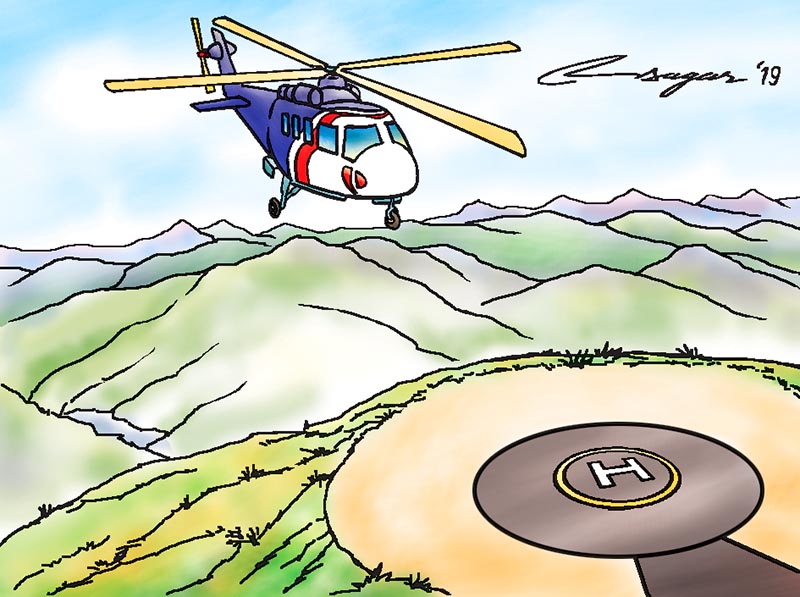Helicopter country: Safety a major concern
Helicopter manufacturers say that Nepal is a helicopter country. Recently, the Nepal government adopted a policy of building suitable helipads in 753 local units of the country. CAAN has issued directives with detailed guidelines for the same
Recent analysis of civil helicopter accidents from 2006 to 2016 (mainly the major ones) has found that they were related to loss of situational awareness, leading to controlled flight into terrain (CFIT). In all those accidents analysed, the pilot lost situational awareness and inadvertently flew the aircraft into the mountain slope due to lack of external visual references and weak instrumental flying skills. It was also found that all of them were caused by human error.
Instances of take-off, landing of helicopters in low visibility and flying in bad weather are the main reasons behind the accidents. Frequently, pilots are under pressure to ignore minor deficiencies and undertake helicopter sorties. So, helicopter pilots must refrain from operating in bad weather if they feel the need to do so.
In order to enhance flight safety in helicopter operation, attention needs to be focused on the following: Regular ground training of pilots is an important measure towards improving safety; discussing various operating scenarios and reviewing recent helicopter accidents to determine the causative factors; mandatory ground training on adverse weather effects of the pre-monsoon and monsoon, disorientation, situational awareness and CFIT help the pilot to make good aeronautical decisions.
At present, we have 10 helicopter operators and four more are in the pipeline. Most of the pilots of these operators may not meet other pilots operating similar types of helicopters to share experiences in handling various emergencies. Mandatory ground training offers a forum for communications between the pilots through problem sharing and situation recovery discussions.
Helicopter Society of Nepal (HSoN) is dedicated to the promotion of helicopters as a safe, effective method of transportation.
The Civil Aviation Authority of Nepal (CAAN) in collaboration with HSoN has revised the heli lanes of Tribhuvan International Airport (TIA) in order to expedite smooth, safe flow of helicopter traffic inside the Kathmandu Valley and reduce the traffic congestion at the TIA. In order to implement the revised heli lanes, Helicopter Society has already carried out the necessary briefing to all the concerned helicopter pilots, flight dispatchers and Air Traffic Controllers in the presence of the Director General of CAAN.
The traffic situation at the domestic airports of Lukla and Pokhara also demands heli lanes. Pokhara has a mixture of different types of aircraft (fixed wing aircraft, helicopters, ultra-light aircraft and also paragliding). The number of movements has exceeded 245 a week. At Lukla, the number of aircraft movement on average is 240 a week. There are eleven helipads at Lukla. During my visit there in October, I observed helicopter movements were almost double that of the fixed wing aircraft. So, in order to reduce the traffic congestion, Helicopter Society has already submitted a proposal for four heli lanes in Lukla and seven in Pokhara.
Helicopter manufacturers say that Nepal is a helicopter country. Recently, the Nepal government adopted a policy of constructing suitable helipads in 753 local units of the country. CAAN has issued directives with detailed guidelines for the construction of helipads by the local authority to ensure safe operation of helicopters.
It is noteworthy that the Civil Aviation Safety Regulation Directorate in July 2016 issued detailed guidelines for the construction of helipads on the rooftops of hospitals to ensure safe and reliable helicopter services. At present there are three hospitals with rooftop helipads with facilities to provide helicopter emergency services. Some more hospitals are in the pipeline ready to provide such medical emergency services.
Another factor is that for communication network to reach every nook and cranny of the country where conventional means of transport cannot penetrate, helicopters are a must. Their vertical take-off, mid-air hovering and low-flying abilities are specific advantages they have over conventional airplanes. While it is a norm in the west to have helicopters with qualified medics as emergency ambulances, this concept is still in its nascent stage in our country. Medical attention in the golden hour increases a patient’s chance of survival, and helicopters win the race to the hospital helipad over surface ambulances driving through choked roads.
Disaster management is yet another sector where helicopters stand in a unique position to assist with the rescue operation as seen during the last major earthquake in Nepal.
More than 70 per cent of our country lies in the Himalayan and mountain regions. Within this region, there are short take-off and landing (STOL) airports at Lukla, Manang, Dolpa, Jumla and Simikot. Areas other than those airfields are accessible only by helicopters. In case a trekker or mountaineer falls sick or is injured, he or she can be rescued by helicopter only.
Very recently, HSoN carried out an inspection of the existing rooftop helipads of the hospitals inside the Kathmandu Valley to enhance the safety of helicopter flights in providing emergency medical services and also to establish uniformity in the Standard Operating Procedures (SOP) of helicopter flight operation. Further discussion on the subject matter will be conducted as soon as possible after proper co-ordination with all the stakeholders.
Dongol is executive director, Helicopter Society of Nepal






